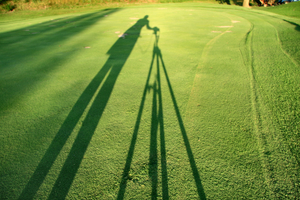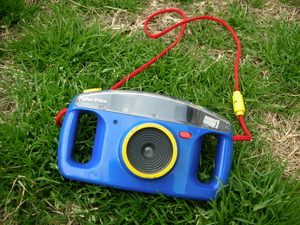The Gear
I won’t make too many recommendations for brands of gear to use. We all have our preferences, and really it all boils down to what you are comfortable shooting with. If you are uncomfortable with your equipment and cannot work it correctly, it will do you no good. I will however from time to time state that my preferences are in gear selection.
There are a few things I would never leave home without before shooting landscapes, in no particular order:
- Tripod
- Polarizing Filter
- Graduated ND Filter
- Regular ND Filter
- Camera
- Wide Angle Lens and Telephoto Lens
- Extra Batteries
- Extra CF Cards
- Lens Cleaning Cloth
All of those items are essential to my landscape photography, of course there are other little odds and ends that I sometimes need, but those aren’t absolutely necessary at all times. Let’s go over them, one at a time…
The Almighty Tripod

They come in all shapes and sizes
In good landscape photography, it’s important to have your scene composed perfectly, and keep it that way… for a while. A lot of landscape photography is finding a good scene and waiting; waiting for the light to become perfect or for the wind to die down. Maybe you want to try different filters, or different settings to see what looks best. Unfortunately, you cannot keep your scene composed perfectly while hand holding; this is why a tripod is essential, among other reasons.
One of those other reasons is sharpness. Often while doing landscape photography, we are using slow shutter speeds. To avoid camera shake and get the sharpest images possible, I recommend a tripod that is nice and sturdy. A cheap $30 tripod will not cut it – expect to spend at least $200 on a good set of legs and a head, sometimes up to $1,500 for the best quality.
Speaking of legs and head, I prefer legs that are independently tilt adjustable, and a pistol-grip ball head. Having legs that are independently tilt adjustable means that I can put my tripod on pretty much any terrain, have it very sturdy, and have the top of my tripod be level. A ball head is so much easier for me to get the exact angle I want than a traditional pan/tilt head, and the pistol-grip makes it faster.
Another great reason to have a tripod is for artistic effect. It is absolutely essential for using very long shutter speeds when shooting waterfalls (I’ll cover that later), and you cannot do it without a tripod. Well technically you can rest your camera on something, but come on… the tripod makes it so much easier and safer.
Are tripods always necessary? No; sometimes an amazing landscape opportunity might present itself suddenly, and you just cannot break out the tripod in time to get the shot. That’s fine, as long as the light is bright enough to not necessitate a slow shutter speed, you are O.K. with not being to easily use certain filters, and you understand straightening and cropping may be necessary in post.
Essential Filters
There are 3 main types of filters that are essential to my landscape photography:
- Circular Polarizer (Polarizing Filter)
- Neutral Density (ND) Filter
- Graduated Neutral Density (GND) Filter
With modern digital cameras and lenses, UV (Ultra Violet) Filters and B&W (Black & White) filters are unnecessary. Some people prefer to always leave a UV filter on their lens to protect the front element of the lens from scratches; however this interferes with putting other filters on, and having the lens cap on the lens when it’s not in use is better than a UV filter for protection any way.
Later in the Landscape 101 series, we will cover what these filters do and how to use them effectively.
Camera
The camera you use, should be one you are comfortable with. In today’s day and age obviously I’d recommend a digital camera over film, though for nostalgia’s sake sometimes it’s fun to shoot with film for a day.

Most cameras will work; this one probably won’t.
No matter which digital camera you pick, make sure that you can easily use lens filters with it, and that it has full manual controls that let you control the Aperture, Shutter Speed, ISO, and White balance. If you are planning on making large prints, more megapixels is always better, but megapixels are not everything when it comes to image quality. Other factors such as the quality of the glass in the lens and the size of the pixels on the digital sensor can come into play when determining the quality of larger prints.
Lenses
While a various assortment of lenses are good for landscape photography, I mostly use ultra wide angle lenses such as the Canon 17-40mm F/4L. My style of landscape photography is to get as much into my scene as possible, and incorporate foreground elements in focus with background elements at an ultra-wide angle to include everything in the scene. Sometimes, I’m not able to step into my scene, or I want to maximize far-away details such as a barn on a distant hillside, and a longer focal length is necessary. For this reason I usually carry a telephoto lens, such as the Canon 70-200mm F2.8L lens with me.
For landscape photography, I almost never use prime lenses; a fixed focal length is too limiting. You are dealing sometimes with large, vast scenes, and unlike portrait photography, moving your body a few feet in different directions may make no difference at all in composition. For this reason, I almost exclusively use zoom lenses for my landscape photography; I know that no matter my scene, I will be able to compose it perfectly.
Extra batteries, cards, cleaning cloths…
This is all pretty standard. Why would you want to leave home without them? You could be out on a landscape photography adventure, see the most amazing scene with the perfect light, and your battery could die. Or your card may be out of space. Or your card could be corrupted. Why risk it?
Cleaning cloths are a no-brainer, especially if you are taking photos near wet environments such as waterfalls where a mist of water may coat your lens, or dusty environments.
Continue on to Landscape 101-3: Finding The Light –>


[…] Continue on to Landscape 101-2: The Gear –> […]
[…] Continue on to Landscape 101-2: The Gear –> […]